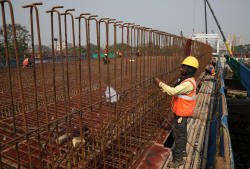India goes on a spending spree to boost growth, stokes concern over
fiscal deficit
 Send a link to a friend
Send a link to a friend
 [February 01, 2022] By
Manoj Kumar and Aftab Ahmed [February 01, 2022] By
Manoj Kumar and Aftab Ahmed
NEW DELHI (Reuters) - India's government
will step up spending to 39.45 trillion rupees ($529.7 billion) in the
coming fiscal year to build public infrastructure and drive economic
growth, it said on Tuesday, but it involves a wider fiscal deficit than
targeted and record borrowing.
Asia's third-largest economy has been on the mend after the government
lifted mobility measures in June to curb the spread of coronavirus,
after contracting 6.6% in the previous fiscal year.
Finance Minister Nirmala Sitharaman, presenting the annual budget to
parliament, said total government spending in the 2022/23 fiscal year
beginning in April will be 4.6% more than the current year.
Trillions of rupees will be allocated to expressways, affordable housing
and solar manufacturing to put growth on a firmer footing, she said.

Growth is estimated to be 9.2% for 2021/2022, coming off a low base and
slowing to 8 to 8.5% in the coming fiscal year, still the fastest among
the world's major economies.
GRAPHIC - India's Economic Grow in Modi's tenure
https://graphics.reuters.com/INDIA-BUDGET/INDIA/klvykmzowvg/
chart.png
The recovery from the pandemic has been swift but incomplete, officials
say. Private consumption has been hampered by a lack of jobs, depleted
household balance sheets and wider income inequalities.
Sitharaman said public investment must continue to take the lead and
pump prime private investment and demand.
"The economy has shown strong resilience to come out of the effects of
the pandemic with high growth. However, we need to sustain that level to
make up for the setback of 2020/21," she said.
She announced spending of 200 billion rupees ($2.68 billion) for a
highway expansion programme and said 400 new trains would be
manufactured over the next three years.
The fiscal deficit for the current year would be 6.9% of GDP, slightly
more than the 6.8% targeted earlier, Sitharaman said, drawing concern in
the bond market.
For the next fiscal year, Prime Minister Narendra Modi's government is
targeting a deficit of 6.4% of GDP, hoping to build on higher tax
revenues and privatisation of state firms including a share sale of
giant insurer Life Insurance Corporation.
“It’s a big bang budget, but depends on where one stands on the bang
perimeter. The massive ramp-up of capital spending and focus on
infrastructure cements the budget’s credentials as a firmly
growth-oriented one," said Aurodeep Nandi, India Economist and Vice
President at Nomura.
GRAPHIC - India's fiscal deficit shot to record highs in 2020-21
https://graphics.reuters.com/INDIA-FISCALDEFICIT/INDIA/byvrjmzllve/
chart.png
[to top of second column] |

Workers tie irons rods at the site of an under construction flyover
in Kolkata, India, February 1, 2022. REUTERS/Rupak De Chowdhuri

Gross borrowing for 2022/23 was raised 40% to 14.95 trillion rupees. Gross
borrowing by the Modi government has more than doubled during the pandemic as
New Delhi went on a spending spree to cushion the economy and provide relief to
the poor.
The benchmark 10-year bond yield IN065432G=CC rose 15 basis points, posting its
biggest single-day rise since May 11, 2020. It had earlier hit levels last seen
in early July 2019. The rupee INR=IN closed 0.2% weaker at 74.79 to the dollar.
GRAPHIC - Retail inflation since India's Modi came to power
https://graphics.reuters.com/INDIA-INFLATION/INDIA/zdpxoqmqyvx/
chart.png
"Despite the higher than expected growth, we still saw a fiscal deficit that was
wider than what was budgeted. That continues to demonstrate the risks that are
still ongoing from the pandemic," said Christian de Guzman, senior vice
president, at Moody's Investors Service.
GARPHIC - India Govt Borrowing More Than Doubles Over 5 Yrs
https://graphics.reuters.com/INDIA-BORROWING/INDIA/movanyjgnpa/
chart.png
Stocks were higher on the growth-oriented budget with the blue-chip NSE Nifty 50
stock index gaining 1.37% and the S&P BSE Sensex adding 1.46%.
SLOWER PRIVATISATION, DIGITAL CURRENCY
The government sharply scaled back its plans to sell state-run companies after
political criticism and market turmoil, expecting to raise 650 billion rupees
from the privatisation programme next fiscal year, lower than the revised 780
billion target for the current fiscal year.
Initially, it had announced it would raise 1.75 trillion rupees this fiscal
year. After years of efforts the government succeeded in selling loss-making
carrier Air India last month, but failed to move forward on other companies and
banks identified for sale.

Sitharaman also said the central bank would introduce a digital currency in the
next fiscal year using blockchain and other supporting technology.
India's central bank has voiced "serious concerns" around private
cryptocurrencies on the grounds that these may cause financial instability.
($1 = 74.5550 Indian rupees)
(Additional reporting by Delhi, Mumbai and Bengaluru bureaux; Writing by Sanjeev
Miglani; Editing by Jacqueline Wong, Raju Gopalakrishnan and Louise Heavens)
[© 2022 Thomson Reuters. All rights
reserved.]This material may not be published,
broadcast, rewritten or redistributed.
Thompson Reuters is solely responsible for this content. |